
Latest
News Profile
Writings
Artwork
Booking
Schedule
Links Email
Character
Galleries Message
Board Guest
Book Chat
Room
![]()
My Own Experiences
by Suzanne Muldowney
In my case, "how it all began" involved not Underdog, but Superman--at
least seven years before the Underdog show came to be.
Superman came into my life when I was 5 to 6, in the mid-50s. I forget just
how I was first exposed, but definite sources were comic books, coloring books,
and the vintage TV series starring George
Reeves.
What fascinated me most was the aerial element. (Consider that there are a great many fictional heroes, only a few of which fly.) Whenever I involved myself in reading or watching Superman stories, I would always await his next "flight." Especially when watching the TV series, I would become bored by the slow-paced stories, especially since I had not yet the intelligence level to understand them. I would always think, "When is Superman going to fly again"? When is he going to come to the rescue?" Naturally, I would attempt to fly as, no doubt, many other very young Superman buffs did--only to be baffled and disappointed at my inability to remain airborne following a "takeoff." I remember that part of the time, in the course of a romping emulation, I would settle for running around the room.
I was also highly attracted to the heroic and goodwill elements, mostly because
these were presented on a larger-than-life scale in the flashy pictures and
fast-paced stories in the comics and coloring books. The Superman craving
faded, in time, mostly because I had begun first grade and was becoming engrossed
in school life. Nevertheless, definite influences, which supposedly had vanished,
would manifest themselves again. I think my first exposure to the Underdog
character and series occurred shortly after its '64 debut, but did not develop
a grip on me until a while later.
Ironically, I was not first among my family to watch the show. Two of my brothers
did it first; I discovered it only because it preceded another show I liked.
Because I would enter the room just as Underdog was finishing, I gradually
became curious and, in time, found a story or two I liked. Shortly after the
start of '65, the "beckoning" became stronger, mainly because of
two elements: a motion picture and a comic book.
On the verge of Spring '65, and in coincidence with Lent-Easter, The Greatest Story Ever Told, a reverential dramatization of Christ's public life, premiered. Being Catholic, and having been educated in first through third grades in a Catholic school by overbearing nuns, and also having been tested further by my parents, I had long been fascinated by Christ's life story, not to mention greatly saddened about the incidents of the Passion. Once during my second-grade term, the altar boys at my church staged a Passion Play; I was overwhelmed by the general concept of dramatization and the more important point of acting out the Passion. Now, with the premiere of the movie, I was again deeply moved by the performance and wished that I was acting the role of Christ--because I could identify with attempting to be an ideal person, wanting to do good, and somehow being ill-treated for it. (Some of my fellow classmates, in the early grades, made me a target of their malicious teasing!)
The second crucial element was a story found in a Dennis the Menace comic
book. Dennis's prudish girl neighbor, Margaret, was on her way to a ballet
lesson. Dennis, scoffing ballet dancing, watched her perform a few steps.
The steps she demonstrated--high kicks, leaps, and spins--made her appear
superhuman, phenomenal. As I read the story a number of times, I grasped a
clue: these kinds of steps, although performed by ordinary mortals without
specialized equipment, somehow made those people better than normal--in this
case, significantly closer to superhuman status. Using certain jumps, leaps,
spins, why couldn't I use them to play the part of a flying superhero?
From this point, I began watching Underdog more frequently, hoping to find
more stories I liked, and also because I felt the urge to assume his identity
due to the heroic--and aerial--elements. Because ballet dancing was the apparent
"right" kind of theatrical body movement, I had to educate myself
on it through a few scattered books I had acquired several years earlier but
had ignored. (This was actually my second exposure to ballet because the first
time I was concerned only with the shapes and workmanship of tutus; their
overall appearance was more important than any formalized movement. I never
took lessons then.) Also, since ballet used serious classic music rather than
blues, rock-and-roll, or other "light" styles, I had to listen to
my father's records, some of which contained sonatas, concerti, symphonies,
etc., and others of which contained music written expressly for particular
ballets.
I could sense the craving coming on, but I also tried to fight it. Because
I was nearing age thirteen, I had had previous experience with other phases,
notably in terms of obsession so that I apparently ate, drank, slept, and
talked solely in line with the dominant topic; my parents had rebuked me severely
for this. Now, if another topic was taking hold of me, I had to keep it secret
rather than attempt to share it and risk antagonism. (How many people have
had identical situations: either as children, they were so fond of something
that they spoke of it constantly and were criticized; or, as parents, they
reproach their own children who seem too fond of something?) I tried to fight
the oncoming Underdog obsession by sidetracking it to ballet-oriented channels.
I thought of a super-heroine ballerina, who used big leaps and jumps to travel,
and combatted enemies with kicks, spins, and other ballet "stunts."
Drawings I made at this time showed all the characters, especially my "super
ballerina" and her foes, wearing tutus and acting out the stories on
a stage. But as time wore on, drawings I continued to make showed the main
character's costume be-coming more and more that of Underdog, and the main
character gradually losing the elements of femininity, another name, etc.
Finally there was no turning back: my topical character was Underdog, in his
costume, and with all his "official" friends and foes. As for the
drawings, I had to keep them concealed In the early fall of '65, something
happened which proved a "grabber." A story entitled "Pain Strikes
Underdog" emphasized that he had a birthday approaching; as the story
progressed, he suffered a "stabbing pain" in his back. The show
concluded that day with his incapacitation and crooning sympathizers. I felt
very touched at this idea of the hero undergoing misfortune.
At this time, the shows were still being run so that two in succession were
necessary to cover one whole story. In the days I spent waiting for the concluding
segments, Pope Paul VI came to the United States and celebrated Mass in New
York's Yankee Stadium. The high emotion of the services moved my mother to
tears as we both watched the ceremonies on TV; I felt the same deep emotion
but in terms of concern over a loved one's plight, the way "the whole
world mourned his [Underdog's] plight," according to the narrator. (Of
course, the story concluded by showing that the injury had been due to a sword
lodged in his cloak.) Nevertheless, I had had a profound emotional experience
which was a further "calling."

As Thanksgiving Day 1965 drew near, the Underdog installments concluded with a commercial for a special Thanksgiving-oriented show to be broadcast immediately after Macy's/New York Parade. Moreover, parade-related announcements said that Underdog would be implemented in helium-balloon form. I had not watched any televised parades since I was a few years younger. Now that something specific was on one's agenda, I was obliged to watch. There were the customary floats, bands, celebrities, and some other favorite characters in balloon form. At about 11 a.m., a singing group came before the cameras, but I could see the Underdog balloon coming up from behind! I began to breathe rapidly; my heart beat faster. But then there was a commercial. When the program resumed, the time was about 11:07. Bonanza's Lorne Greene, who was one of the commentators, assumed an almost reverential tone of voice as he introduced the Underdog balloon as the next entry. Then the cameras shifted to the enormous balloon, and a march I had come to recognize from the show was piped in over the PA, to be followed by the Underdog theme song. At the conclusion of the song, a "Simon Bar-Sinister" appeared on the street, wielding a large gun, and staging, of course, a mock disruption--that of stopping the parade. A "Polly" came alongside him, crooning over the state of affairs. Next was piped in the "recognition" password as the Underdog balloon was again made the center of attention. Angered at the sight of him, Simon wielded his "smoke gun" and yelled, "Simon says--go up in smoke!" There actually was a blast of smoke. Of course, "Underdog" survived. Simon yelled twice, and fired two more blasts, but to no avail, and had to surrender. Polly congratulated Underdog, and the balloon crew continued down the street and around the corner as Lorne Greene intoned, "Good show, Underdog!"
I had been riveted before the TV during this entire presentation. Indeed,
it was significant that Macy's had chosen to make a big presentation at that
point. Of course, there were feature presentations before and after the Underdog
balloon, but the fact that this, the balloon's first time, had had a major
presentation built around it, implied that the Underdog character was of major
importance to children nationwide, if Macy's had chosen to implement it in
their parade. Once the parade concluded at noon, I waited for the special
Thanksgiving episode to begin, as advertised earlier and as spoken by a technician
as the credits were playing. The noon program came on--but it was not the
special Underdog show, only the normal local noontime newscast! I couldn't
figure out what had happened, and began to cry. I cried so hard that my mother
made a mysterious phone call. She must have called a major television outfit
because a while later, she and my father told me that, according to whom they
had phoned, the show had originated in New York City. The special episode,
although advertised as apparently being telecast nationwide, was shown only
in the New York area. Something advertised on a network was seen only on one
area's affiliate of that network.
The events and emotions
of that Thanksgiving Day 1965 (November 25) proved to be the "clincher."
I was in love with the character--although I had to convince my family that
I liked it only a little--and I was drawn to impersonate him-through ballet
dance, especially now that I was taking ballet lessons. I had purchased a
sewing pattern consisting of girls' ballet costumes. I was making myself several
tutus, but somewhere at this time I was also making a red leotard, to serve
as an Underdog costume. I tried to keep it secret, but my mother threateningly
claimed she knew everything. Finally, on January 8, 1966, I performed Underdog
for the first time, in costume, before the TV set. The adventure shown that
day, interestingly enough, was my favorite.
As the weeks and months
passed, every Saturday morning I went through the same ritual "performance."
Somehow I was able to have the TV room all to myself at the one right time;
my two older brothers seemed to have given up watching it. But they, and also
my parents, gave me monumental scoffing, not to mention condemnation of a
character they considered inappropriate for someone my age. In my Underdog
impersonations, I was using ballet steps to depict his movements, especially
the flying, mostly because female ballet dancers-whether students or professionals--were
trained to be light and airy, as though part fairy or bird. (Female "bird"
ballerinas certainly applied in The Firebird and Swan Lake.) I also was using
various classical musics to make a constant musical "bed" for every
adventure. As I envisioned it, every adventure became part straight-drama
and part ballet, due to a performing-arts umbrella of sorts. (Mighty Mouse
was another example of persistent performing-arts implementation. Opera was
the medium, in that there was a constant musical bed and an operatic tenor
and soprano whose voices served as those of Mighty Mouse and his girlfriend.)
About one or two months after my "debut," a show called Cartoon
Cut-Ups began running on Sunday mornings; it starred Underdog as well as two
other Jay Ward Productions characters. Now I was "performing" two
days a week.
Sometimes I would
perform before my parents or their friends and relatives. As long as I portrayed
or suggested characters from established ballets, all was well; but anything
suggestive of Underdog, although I was not in that costume, was outlawed by
my parents.
Frequently during the spring and summer of '66, I would play near sundown
with my youngest brother, who had fallen for the Batman TV series. We would
pretend we were a super-hero team. Because he was six at that time, my youngest
brother could get away with wearing a character costume, but I could not.
My father berated me for our playing because it was the only way I could live
out my own fantasies without costuming myself accordingly due to my age. I
think I stopped this when school began for the '66-'67 term.
My oldest brother was now becoming something of a heckler. He loathed my emulating and impersonating Underdog and would sometimes barge into the room during my "Performances." My parents would chase him out; I was made even more nervous by their presence as, no doubt, they despised my actions even more than my brother did. In the first week of August '66, the family went on a vacation trip to Niagara Falls. But because, according to our itinerary, we would not be back home in time for the Saturday morning show, I was deeply disappointed, since I wanted to see it in private; the upcoming story was one I had seen before but--more importantly--it had become one of my favorites. The time came and all of us children were in the one hotel room with a TV; I had been unable to bring my costume along, and could not "perform" up to par since my brothers were watching the show--and my every move.
On September 3, 1966, 1 was "performing" to that day's installment
but was also suffering an unusually discourteous assault from my oldest brother.
He was booing Underdog's moves and cheering the villain's; he was also heckling
as would a baseball fan discontent with the game's action. When the show finally
ended, my brother shouted, "I hope that's the last time you ever do this!"
I actually thought my brother's wish came true when, on September 10, I tuned
the TV to the channel to which the show had been shifted. But the program
failed to come on! (This was the time when Underdog was shifted from NBC to
CBS. ) In the weeks that followed, with no Underdog to watch, I had a severe
letdown. My parents, however, were glad about the apparent discontinuation.
After several weeks, though, another program, The Beagles, also created by
Jay Ward Productions, premiered--with Underdog as a guest celebrity. For about
a month these guest appearances went on; finally the regular Underdog program
returned. In the interim, though the regular show had not been seen, it had
been listed in the papers; now the network had had to adjust their schedules,
as had been the case for Thanksgiving '65, to ensure the accuracy of their
schedules and the availability of the program for viewing in all areas. (Interesting
questions: did CBS receive complaints when Underdog failed to show in some
areas? Did they adjust their schedules to appease children, out of concern
for the popularity and welfare of the character, or merely to protect an investment?)
I forget exactly when, but somewhere around this time, the show's format was
changed so that any one story could be covered in its entirety within one
half-hour segment, instead of the previous halving over two successive weeks.
On Christmas Day 1966, I received a surprise present from my mother: a Whitman's
children's storybook containing an Underdog adventure. (Though I was delighted
with it, I was also quite baffled, since my parents hated the character and
show so much!) Since it had no official name, I named this story "The
Fateful Contest," after a title given the account of the Athena-Arachne
weaving contest, in one of my schoolbooks containing famous Greek myths. Simon
Bar-Sinister had invented an energy pill that surpassed that of Underdog,
who insisted upon running tests between pills. I had discovered Underdog in
'65 and had begun impersonating him in '66. The phase lasted until the end
of the summer of '68, at which time I thought I was permanently over it but,
instead, would come back to it. As long as I continued to pursue the program
and portray the title role, I was incessantly needled by my parents. Though
both of them loathed my ideal, I was harassed far more by my father than by
my mother.
One thorn my father
would relentlessly put in my side was his assertion that Underdog was for
someone my age or sex. I was supposed to be interested in the same things
as were numberless other teenage girls; many of these "mandatory"
interests I found not all that great. (Two such items were boys and ever-changing
fashions, since my school was all girls and had its students wear uniforms.)
Another persistent
thorn in the side was my apparent inability to distinguish fantasy from reality.
I thought I could distinguish between the good and the bad, the real and the
imaginary, the strong and the weak, etc., but was not given the benefit of
the doubt. One significant outgrowth of this was my father's compel-ling me
to read or watch more realistic stories which, although they were still fiction,
were more down-to-earth, believable enough to pass for real. He would check
up on me, as if he were one of my schoolteachers, on my progress of having
read books or watched more realistic television, and tried to outlaw any amusement
in which I did not learn something from it.
He criticized the show and the stories as being below my intelligence level. Somehow I was expected to gain some knowledge from what was shown, or the stories should have been suited more for adults' intelligence than children's. I was reminded of the programs and movies I had seen as a little child but was unable to understand at the time, having not yet reached that intelligence level--although these entertainments had been emphasized and marketed as family entertainments. Apparently they weren't "right" or "appropriate" unless they challenged the intellect, so that the consumer was given a subsequent quiz or exam of sorts. Previously I have stated how I would look for music to back up the stories. Because such high-class dancing like ballet called for equally high-class music, my father branded the Underdog TV stories "very poor drama for such serious music."
One time I was "knifed" over my personal appearance. I wore my hair
then the same way I do now: shoulder-length and straight down. Sometimes when
viewed from the sides or at three-quarter distance, my flat "panels"
of hair resembled a hound's ears; along these lines, my father once growled:
"I can't stand the sight of you like that because your hair looks exactly
like Underdog's ears!" I burst into bitter tears immediately. Apparent
unwritten law and/or general consensus was that this character and series
(and all others) were unacceptable unless they had high intelligence levels,
generally believable stories even if the characters and events were imaginary;
had realistic but not obscene or "dirty" language, had sophisticated,
sensible characters, and were not strictly "escapist" or amusing
but perhaps educational or challenging. Otherwise, these products were a bad
example for life just as dramatized violence is condemned to be. (Tennessee
Tuxedo always had an informational segment in each of its episodes when scientist
"Mr. Whoopee" explained different machines" functions. Fantastic
Eighth Man, a robot super-hero originated from Japan, had super-deeds and
interactions with people far more realistic and representative of real life
than Underdog ever did; I frequently wished the Underdog show had been more
that way.)
I was trapped by the implications that anything I wanted to do for amusement
had to teach me something; that any dramatizations I watched had to be nonfiction,
or as close to it as possible; that stories I read or pictures I drew had
to depict real-life situations; and that some compositions or stories I wrote
had to be real. Attitudes and mandates like these resembled viewpoints of
the Puritans of old, who attempted to make life an eternal ordeal by outlawing
any kind of amusement unless it was in imitation of life at its direst. There
might as well have been a Biblical commandment of sorts: "Thou shall
not fantasize." (One scandalous example of the public's concerning itself
over a non-existent character was when the Dallas TV series ran the "Who
Shot J.R.?" campaign. For months, the public fretted over this mystery;
expectedly, there were letters to the editor, indignant over the concern with
a fictional crime when numberless real (and worse) crimes occurred every day.
)
There were two very important concerns of mine all the time I followed the
Underdog series as a teenager. I was so afraid of my family and their criticisms
that I never told of these special traits. The first was triggered by the
constant guff from my family: I improved upon the characters and series in
my mind. What had proven a terrible shock was the meaning of the word "underdog."
I had never heard the word until I became acquainted with the series. When
my father force-fed me the dictionarial definition, "born loser,"
"disfavored person," I was stunned. If that was the meaning of the
word, why had the series' creators chosen that name? Moreover, why did they
choose to make the show the campy travesty it was? Didn't they realize they
risked scrutiny and negative feedback, with possible demands for improvement?
My aim was clear: the Underdog character and series had to be dignified and
sensible. I had to revise virtually every story to make it more believable.
(In 1986, DC Comics, at the hand of John Byrne, revamped the Superman character
to fit him better with the present-day world. This way--to the disappointment
of many purists--his classic powers were modified, lessened (!).) At the conclusion
of every story, there would be a preview of the next one. I had to see a whole
story to understand its plot; upon learning that any one story was coming
back, I analyzed and improved upon it during the intervening days, so that
once it was aired on the TV, I was "performing" before it but with
the amendments.
Several stories I found irreparable, and discarded them altogether. The majority of others had to have events altered to make better sense. My revamping of incidents resulted in some characters' undergoing "plastic surgery" of sorts. Naturally, Underdog himself had to become better. He no longer crashed through surfaces when coming or going, was more intelligent so as not to become so easily entrapped by his foes, was not so dependent on Polly to determine his course of action, and shed the slapstick to be more a hero and not a comic.
One character I omitted altogether was Underdog's alter ego, Shoeshine Boy.
I had never liked the idea of a shoeshiner and could never dream up an alternate
satisfactory cover-up. (Wonder Woman's alter ego was highly respectful--that
of Diana Prince an Armed Forces lieutenant.) I decided: why a cover-up at
all? Let Underdog stick solely with the one identity and enter and exit as
needed for rescue purposes.
My second major concern was my determination never to think of Underdog as a real being, and to cast myself as an actress playing the character rather than as the character itself. Unlike the conventional younger fan who would don a self-executed costume and romp about, and perhaps believe everything he saw was real, I knew the characters and events were imaginary. I imagined myself an actress (better, half actress, half dancer) onstage, acting out the stories in a theater before on-lookers, with additional actors as the other characters. I imagined rehearsing a story during the days before that story was to air, taking positions in the wings, coming and acting and going at the proper times, and taking bows afterward. Because every installment had a preview of the next show, I imagined that when the commentator announced the preview, I came out "onstage" for a solo bow and was presented with a floral bouquet by Wally Cox, the actor whose voice was that of Underdog. Sometimes I wished that other fans, if I could find and locate any, could join forces with me and perform outside the confines of our homes. This never came to pass, and probably would have been squelched anyway.
For the Thanksgiving Parades of '66 and '67, I again saw the helium balloon.
Unlike the first time, the balloon carriers did not stop in the middle of
the square to let other people build a big production around the balloon's
presence. But Lorne Greene, still serving as commentator, continued to laud
the character in a reverential tone of voice, implying that he was a fan of
sorts. "Underdog, keep flying high!…Oooh, it's Underdog! He flies
again!…Save the day for us!" I imagined that there was no balloon,
that I was out there on a float; and that after the parade I was performing
that Thanksgiving-oriented episode in one of the high-class theaters.
A few times during the summer of '67, 1 wished that I could make personal
appearances as the character. These times my family went to Ocean City, NJ
for one-day excursions; during the evenings we separated for a few hours to
pursue our individual interests. It was at those times that I would walk the
boardwalk and wish I could make appearances. The ambition stemmed from a book
I had found in my school library: Homer Price by Robert McCloskey. It was
actually six short stories, the third of which, "The Doughnuts,"
I had read in one of my sixth-grade schoolbooks. Now I was drawn to the second,
"The Case of the Cosmic Comic," concerning Homer and two friends
following the actions of the "Super-Duper" (obviously another Superman
imitation). At one point the three boys went to a Super-Duper movie where
the actor was greeting people in the lobby. Because the author wrote that
the Super-Duper's costume consisted of red suit and tights with blue cape,
I imagined I was cast in the story but substituting Underdog, identically
costumed, for the Super-Duper; hence, my wish to make personal appearances.
The summer of '68 brought about the decline and fall of my original Underdog
pursuits. A few months earlier, with the beginning of Lent, I decided to stop
dancing the part as a Lenten sacrifice; during this hiatus, another topic
caught my fancy and continued to "grow" even after Lent had ended.
By the end of the summer of '68, between the negativism of my family and my
own inability as an individual--and a mere high-school student--to have carried
out a reformation of the cartoon series since I had had no way of contacting
the network or producers, as well as having found other interests, I gave
up the part, thinking it was a closed chapter in my life. Between others'
criticisms and my own failures to have caused improvement of the character
and series, I became a pessimist, unable to think of the slightest good point
about the show. I recoiled from commercial toys named after Underdog and changed
the TV channel if I came upon the show by chance. I refused to watch the Macy's
Thanksgiving parade so that I would not see the balloon. When I heard that
some area was syndicating the show, I shunned watching it since it not only
triggered bad memories but also perpetuated all the aforementioned programmatic
flaws.
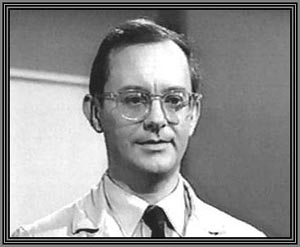
Wallace
Maynard Cox
1924-1973
In February 1973, Wally Cox died; I found the article in a newspaper along
with a photo. However, the article stressed his part in Mr. Peepers, with
no mention of Underdog. Because I felt obliged to sever myself from the latter,
I felt no great loss from this death. However, my father, upon returning from
work that evening, questioned me, "Why aren't you dressed in mourning?"
I had not danced Underdog now for nearly 5 years.
My first "calling back" occurred in early 1976, when I was researching
the real story of a man who would soon become another of my character specialties:
Dracula. In Search of Dracula by Radu Florescu and Raymond McNally made the
following statement in analyzing Bram Stoker's gothic novel: "Van Helsing
[Dracula's main pursuer] is the real hero; Dracula himself is the underdog."
Seeing that word, and in that sense, I felt I was being called upon to resume
the part!
About three years later, now deeply involved in portraying Dracula through
dance in a few public entertainments and local TV talk shows in different
parts of the country, I decided to take up Underdog again. Unlike countless
other Dracula impersonators who dealt only with Stoker's obvious vampire,
my performances dealt much more with the more important historic Dracula,
Prince Vlad the Impaler; if I could restore this character to his former dignity,
why not rehabilitate Underdog, too? Sometime in 1979 I did make another Underdog
costume and cape, but had to wait until an appropriate opportunity came along.
The opportunity came
the following year. The last weekend of July 1980, I was reading the weekend
activities section of the newspaper and came upon the following: If your mind
wanders to fantasy, consider taking in the Creation Convention happening today
and tomorrow [in Philadelphia]…Comic book dealers and artists will provide
the major draw, with a whimsical costume contest scheduled for tomorrow at
2 p.m. That costume contest was my gateway.
Thus it was that on Sunday, July 27, 1980, at the Creation Science Fiction Convention in Philadelphia, came a "resurrection" of Underdog, and my first onstage appearance, as I had dreamed of doing in the old days. Upon my arrival, I registered for the Costume Contest but questioned the emcee first: were any contestants who wanted to allowed to build big-scale presentations around their costumes? Fortunately, the answer was yes; I had hoped to use big leaps, poses as if in flight, and a few spinning turns.
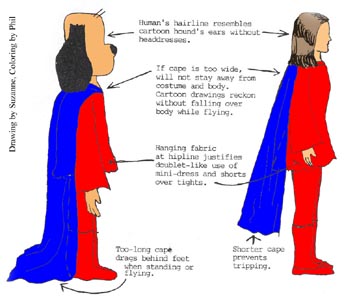
My old-time costume had been a red short-sleeved leotard, crude cape, and
flesh tights. I had a better-formed cape now, and a shiny red, long-sleeved
mini-dress. I used a dress and shorts rather than a leotard since they resembled
the doublet and hose worn by medieval knights (including Dracula). I had to
use flesh tights again for a while until I could buy a pair of red ones. My
new costume was an improvement over my old one as well as over Underdog's
original, since the styling and faulty drawing in the animation made some
parts of it needful of improvement for sensible theatrical use.
Now that Underdog had made his first "new" appearance, I had to formulate a new set of rules and objectives. Naturally, he had to bypass previous errors by being more serious, dignified, intelligent, and sophisticated, in line with the previous demands of the public conscience. He was alone, accompanied by no friends or foes. He had no alter ego. He asserted himself with illusory gestures accomplished within human limitations. He was on exhibition only. He did not damage surfaces or have mishaps when coming or going. He did not speak in the course of a presentation. Such a format may seem like re-inventing the wheel, but it was in line with changes and perpetuations that other characters were going through. Many vintage characters were undergoing "plastic surgery" and becoming far cries from their originals.
I did not do Underdog again until February 1, 1981, when Creation Conventions
returned to Philadelphia. At the first show I had put my name on their mailing
list; now I knew they were returning because I had received a circular as
a result. When I learned of the imminent return, I wrote the director, reminding
him of the entry I had done previously and was there a way to highlight it
in the upcoming show? The result was my first feature spot on a convention
agenda. I did a polished Underdog dance just before the costume competition
and did the character again for the contest itself.
From the start, I kept my resumption of the Underdog role a secret from my family. Though I had moved into my own place three years earlier and was now twenty-eight, my family might still retain old prejudices and impose them on me as law. In May 1981, I went to New York City for another Creation Convention; this was the first I heard that they had New York shows. New York and Long Island, it turned out, were the company headquarters. For this Costume Contest, I did a character other than Underdog; nevertheless, some other activities included showing old-time Underdog TV episodes, converted to movie film! I now had proof that there was still a market for cartoon characters although most of the conventions' inclinations were toward science fiction and comic books.
Sometime in the summer of '81 I danced Underdog as part of an amateur talent
night that some nightclubs in Jersey shore towns had weekly during the peak
season. It was clear that witnesses to my performances recognized the name
and character. They also felt but could not define the change in him from
buffoon to model. On September
26, 1 went to Wilmington, Delaware to enter as Underdog in a costume contest
which was part of another group's activities: Xanadu. I was awarded Best Women's
Entry.
Sometime in the fall
of '81 I learned that Creation was to have another New York-based convention
over Thanksgiving weekend--their eleventh consecutive Thanksgiving show. For
this, Underdog was mandatory: the site was New York, and the time was Thanksgiving-in
coincidence with the time and place chosen by the Macy's Parade for Underdog's
annual big-scale "glorification"! Thus on Sunday, November 29, 1981,
I made my first Thanksgiving appearance in the now traditional format of using
music to back me up while I used representative movements and poses.
I had shied away from strict ballet since the early 70s, since that style was too perfectionist and pre-set. Many virtuoso steps appeased the generalities of that style, but were unauthentic with the character. I had become more drawn to the philosophy of interpretive dancer Isadora Duncan, who did not believe in pre-setting and duplication, but spontaneous choreography with the music as stage director, and with music other than that written for specific theatrical pieces. Equally important was that even during my ballet-training days, whenever I practiced, no one else was present to tell me what moves to make. In the case of Underdog I used big leaps, first arabesques for flight poses, and camel spins (slow or fast) from figure-skating when rotating on one foot.
On June 6, 1982, I again danced Underdog as part of a Creation Convention
masquerade. I was surprised at winning the Most Original award, as the character
was already at least 15 years old!
I had a rather poignant experience on November 14, 1982. That night, the first of the Superman movies, which I had not seen while it had run in the movie houses, played on TV. When I saw how the story engaged sophisticated actors, and made the story and character high-class, almost gods, I cried bitterly. "Why wasn't Underdog ever given that kind of treatment?"
On Thanksgiving Day 1982, after a hiatus of nearly 15 years, I once again
watched the Macy's Parade. When the Underdog balloon appeared, there was no
big presentation. Commentator Bryant Gumbel, though, made the remark that
he was "one of New York's most honored characters." (An interesting
note: this day was November 25, the very same day I had seen the balloon's
first flight in '65!)
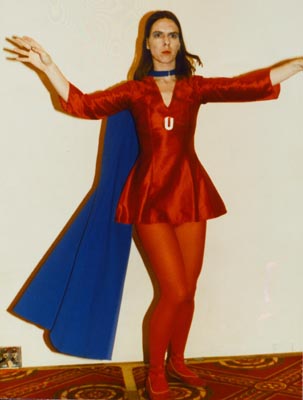
New York Nov 26th 1982
The next day was the start of the Creation Thanksgiving show for '82. In this
show I not only did Underdog in the masquerade--where I won Best Presentation
-but also danced of my representative routines as a feature spot. What also
happened at this show, although I did not learn about it until some time later,
was that two Long Island comic dealers, Pat and Lance, saw me in performance
and were overwhelmed, as I had been overwhelmed by the balloon in '65. Until
seeing me, they could not believe that Underdog could come to life through
an impersonator.
I made one Underdog appearance each month in the first four months of 1983
in Philadelphia, New York, Boston, and Chicago respectively. It was in Chicago
that I was surprisingly successful: after per-forming a feature routine, I
was asked to repeat Underdog for the costume contest rather than use another
outfit I had planned. Moreover, I made a friend of one of the other guests:
Walter Koenig, Star Trek's "Chekov". We discussed Underdog in depth,
and he professed a great interest in seeing me dance it. Unfortunately, that
day he left too early and, as of this writing, has yet to witness my doing
it.
I did not dance Underdog again until October '83, in a convention from Hartford,
Connecticut. In the meantime, I had done some research on the history of the
show in a book on the history of Saturday morning television. It was this
way that I re-learned the year of Underdog's "birth": 1964; next
year he would turn 20. I had been suggesting ideas to Creation as to how to
celebrate the 20th Anniversary frequently in '84. Now, in Hart-ford, I won
Best Presentation, and had the emcee state that a year from now would be his
20th birthday. I had written sets of papers containing ideas for 20th Anniversary
celebrations. Many ideas stemmed from things I had seen on TV or had been
involved in under slightly different circumstances. Many of these formats,
which can be updated to suit the 25th, will be detailed later.
Several months earlier, another convention company had had a show in Philadelphia with an event Creation took on later--perhaps because I wrote to them advising of it!--the Live Play: attendees at the convention volunteered to act out a scene from a popular sci-fi topic. I now wished that people would team with me to act out Underdog episodes. I wrote among some circles of sci-fi and fantasy buffs asking for stories, drawings, etc., but received not one reply.
I had also reached a decision about my costume. Underdog had not had much
luck in the convention masquerades because his costume was not that garish.
I had seen more complex costumes win although their wearers did not have effective
presentations. Because Underdog always left a trail of stars behind him while
in flight or radiating energy I decided to make an extra cape for special
occasions. This Stardust cape would be decorated to symbolize the glittery
trail left in Underdog's wake.
Thanksgiving '83 saw another Underdog appearance in New York--in both balloon
and live appearances, although I won no prize for the latter. Now I was counting
the remaining time until the start of '84, for the first weekend of that year
would have another New York show at which I was scheduled to return.
Unfortunately, only
a few days before 1984 began, I suffered a nervous collapse, due to high pressure
at work and my mediocre status as a dancer in the Philadelphia area. I lost
my job (which had been totally irrelevant to dance) since my nerves worsened
with every attempt to return there.
I could not afford to lose the New York show, as the Creation staff was expecting
me. On January 8, 1984 -18 years to the date I had first danced in front of
the TV set!--I ushered in the 20th Anniversary year and first wore the Stardust
cape.
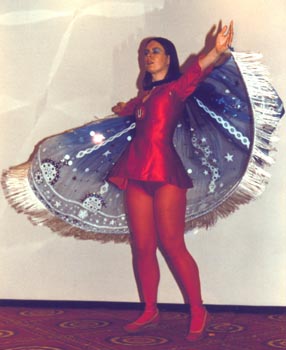
January 8th 1984:
New York
First use of "Stardust Cape
For the first few months of '84, I went to a few conventions, but not as Underdog;
the "target time"--when he would actually reach 20--was not until
October. Moreover, my nerves impeded me from finding other work and from participating
in more activities. I had to cross out several hopes I had had for the 20th
Anniversary: that additional conventioneers would act out Underdog-oriented
stories with me; that I would appear frequently as Underdog in '84 conventions;
that the sponsors and promoters of the original series, whom I had contacted
about the occasion, were going to sponsor me somehow; that some conventions
would be held in areas with vaster stages than were usually used ; and that
there would be any really big-scale celebrations through other circuits. (I
had purchased a pair of roller skates in '83, hoping that I could glide across
vast surfaces as another way of "flying." But I never started any
lessons. More importantly: no stage or floor space was nearly vast enough.)
It was not until early fall of '84 that Adam Malin, the head of Creation,
got together with me to plan a concrete event to mark Underdog's 20th Anniversary.
The first weekend of October was closest to the actual day of October 3rd.
But there were two conventions to be held simultaneously that weekend in San
Francisco and Boston; he had to attend the Con in San Francisco which was
too far and too expensive for me to travel to. The half-hour event planned
for Boston would consist of a trivia quiz, modeling of my costume (with both
the capes), and a pose-down to the old-time Underdog passwords. Unfortunately
it proved a shambles, partly due to the previous guests" running into
overtime and my having to trim my time down because the next guest would not
tolerate having to come on late. Adam Malin lost heart after hearing from
the other staff and claimed he would never mount another Underdog celebration!
Four days earlier--on the "target" date, October 3--I had had better
luck with a group of Montessori school students to whom I began teaching modern
dance one day weekly since the start of the term. I had informed them about
the character and anniversary (it was astounding to see that they recognized
him, since they were only 6 to 12 years old!), and had had them write stories
or draw pictures in the sessions prior to this one. Now these students acted
out the stories they had written (they did not use costumes or do it before
audiences) plus a couple of my own stories. With Thanksgiving again approaching,
Adam decided to try again by implementing a 20th Anniversary celebration into
that convention. This time there were no conflicts of schedule.
The '84 Macy's Parade once again featured the balloon. But when I read the
papers the next day, I learned that before it reached the cameras at Herald
Square, the balloon had made a dive as a result of tricky air currents; the
carriers had some difficulty getting it in order again. Upon arriving at the
convention, I was embarrassed at some patrons' expectations for me to act
out the balloon's mishap!
The special celebration had me repeat--more successfully--the maneuvers I
had done in Boston. Moreover, there was a film presentation of one of the
TV episodes --the one which had been my favorite! And when it was time for
the masquerade, Adam heralded my turn by saying, "It's that time again."
What was further gratification was that this '84 date was November 25. Exactly
19 years ago, I had first seen the Underdog balloon; now here I was, among
these crowds, apparently identified with Underdog.
In the beginning of 1985 I learned of how I had entranced Pat and Lance, the Long Island dealers who had seen my Thanksgiving '82 performance. They claimed that in the future they would make some big-scale Underdog film project, but have yet to even start it as of this writing. Let's not even start with the Disney/Spyglass film for 2005 (?)
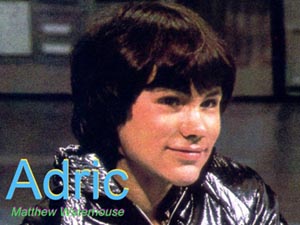
In March and June of '85, I discussed Underdog in depth with a guest who became
another devotee: Matthew Waterhouse,
who played Adric in Dr. Who, I told him of a story I had thought of due to
a drawing of Underdog given me by Pat and Lance. It was their own duplication
of the muscle-flexing, but had Underdog saying, "Support the Olympics!"
My story thus involved him in Olympic-like competitions on a distant solar
system. On July 28, 1985, I appeared again in New York as Underdog, because
Matthew was one of the guests, and because it was now the fifth anniversary
of my first Creation show.
I had a landmark performance when it came time for the Thanksgiving '85 convention.
A local patron recognized me in the hallway. He was a up and coming actor
named Jonathan
Harrison; we discussed my upcoming costume entry, whereupon he offered
to team up with me. We would stage a mock disruption and rescue, as had been
done exactly 20 years ago (!) with the inaugural flight of the balloon (which
had not appeared this time). The time came for the costume parade; I would
be the last to enter. When the previous entries had left the stage, Jonathan
came up the aisle, without any introduction, mounted the stage, and yelled,
"I am the Terror from T.A.H.W.S.--Terrorists Against Hero Worship! I
am hijacking this convention to another dimension!" In the manner of
a mad villain, he laughed maniacally as he brandished a long stick with a
length of ribbon on its end. Now was my time to act. For the first time in
these "new" portrayals, I spoke! From the back of the room and another
aisle, I yelled, "There's no need to fear; Underdog is here!" I
did not speak again after that. Supposedly enraged, Jonathan growled, "How
dare you challenge me? I'll fix you - yes, yes, come to me!" as he waved
the stick and appeared to hypnotize me with the swirl of the ribbon as I proceeded
up the aisle. But as I gained the stage, I spun rapidly like a top, entangling
Jonathan in his own "weapon." "I've failed!" he moaned.
"I must resign my position." As
I flew back down the aisle, Adam remarked, "Let's hear it for Suzanne
Muldowney, the one and only Underdog!" We won Best Presentation. But
it had been the only time someone combined forces with me.
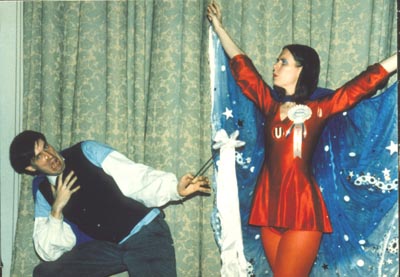
Thanksgiving 1985 with guest "villain Jonathan Harrison
In the spring of '86, I received an invitation to perform an in-depth Underdog recital at a function other than a sci-fi convention. New York University had an annual spring variety show, "Beyond Vaudeville." They explained that Pat and Lance had referred me a la Underdog to them. The show took place on April 30, and was hosted by Daniel Bonaduce, former Partridge Family star. He interviewed me on camera and was mesmerized by my performance. The audiences gave me a standing ovation.
On September 21, 1986, Creation Conventions had their first New Brunswick, NJ show. I appeared as Underdog for this one since Matthew Waterhouse was a guest there and also served as a masquerade judge. At this time I presented him my plot of the Underdog Olympics adventure.
I had made myself another tunic since my other one was continually tearing at the armpits, no matter how much I mended it. The new tunic had a different neckline and fuller sleeves with gussets at the underarms, to allow for exertion and stress in that area.
I had trouble with my traditional Thanksgiving appearance in '86. I was to perform after the Masquerade contestants had had their turns, while the judges were deliberating. When I came onstage, my taped music failed to start; the tape had snagged inside the machine. I could only strike some poses, and without music. Some ill-mannered spectators gave me the evil eye and insulted my attempts, my character, and me as well.
"Beyond Vaudeville" turned out to have a monthly TV talk show on local cable, for which they had me appear on December 8. They had me perform a "flying" routine, but the studio floor space was so cramped I could 'not do it up to par.
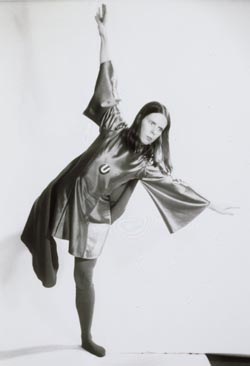
NYU student Magazine
promo shot for
"Beyond Vaudeville" Spring '87 Live Show
On Sunday, January 18, 1987, Creation and Walter Koenig went to Baltimore. I went as Underdog, hoping that Koenig would be one of the masquerade judges. Alas, he had to leave before that contest came around. But he looked over my costume and thought I looked impressive. When it came to the contest, I did what I had originally planned for the last Thanksgiving show: I did a routine during judges' deliberations rather than as a contestant.
There were no more Underdog appearances until Thanksgiving '87, at which time I devised a backup plan: if my player malfunctioned, it was to be shut off and the emcee would use a provided alternate commentary.
On the last day of February 1988, Underdog had an unexpected comeback. CBS TV was airing a 50th Anniversary tribute to Superman. At one point, when the hosts were commenting on characters created in his imitation, some Underdog cartoon footage was used! Underdog was the first of these "clones" to be featured. Hopefully many people who had forgotten the character now had a flash of memory.
Because '88 was Superman's 50th, I was concerned primarily with portraying his equipowered but underprivileged cousin, Supergirl, in his honor. Underdog would have to wait until Thanksgiving '88 and all of the next year, which would be his 25th (Silver) Anniversary.
But while waiting for 1989 to begin, I began working on several special capes. The first was a new Stardust since my other one always lost a few of the trims whenever I exerted myself, since they were made of plastic or acetate and had been applied with glue. The new Stardust cape would have lots of lace, sequins, and other trims sewn on for permanency.
There would also be a special Silver Anniversary cape of silver metallic cloth, with silver trims and white lace.
Both the Stardust and Silver Anniversary capes needed boning, or ribs--like the ribs of an umbrella; half the time I would have to brandish the capes and open them wide to show the decorated insides. Without ribs, any fabric beyond my hands would droop.
It took 8 months for me to make the new Stardust cape, which was first used in Thanksgiving '88.
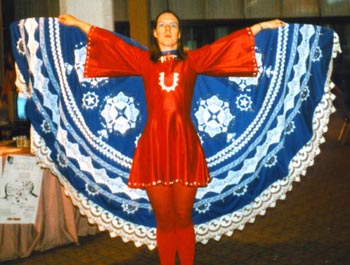
November 27, 1988, New Stardust cape opened to "radiate energy."
One nice element of this show was that the "Beyond Vaudeville" heads visited the convention and, with their TV cameras, taped most of it for their aforementioned monthly talk show. Of course, they made sure to catch my every action.
With Thanksgiving past, I hoped I would be able to do Underdog in some Jersey shore Christmas parades to be held next month. But the town with the earliest parade, in which I had made a few Supergirl appearances during the year, insisted on her again because Underdog would not have been recognized on sight due to lack of previous appearances. He would simply have to wait until the start of '89.
Since the weather was cold for these Christmas parades, I had to make myself a winter woolen 'cape in red for these Supergirl appearances. That meant that in '89, Underdog too would need to "winterize" himself; hence my plans for a winter stardust cape, in blue with white and, silver decors on the inside, for wear in outdoor cold-weather events.
On New Year's Eve, as '88 gave way to '89, I kept saying to myself, "Come in for a landing, Superman; take off, Underdog! The torch is passed."
The first weekend after New Year's there was another convention in Boston. I went to it in order to usher in the Silver Anniversary, as I had done 5 years earlier with the 20th in New York. I had been unable to complete the metallic silver cape and thus used the Stardust. But now I had added some silver ornamentation to the tunic. The date was January 8, 1989-exactly 23 years since my '66 "debut"! I did not take along my tape player, lest there be a mishap. Instead, the emcee was furnished a fashion-show like description of the costume and the news that Underdog was now marking his 25th anniversary. This also proved a landmark achievement because I won Third Prize. For quite some time, the categories had become reduced to First, Second, and Third; 2one were special considerations like Humorous, Originality, or Presentation. Winning Third Place was the highest honor I had yet received for Underdog; hopefully it raised the character's status.
With 1989 underway, I have plans for conventions, of course, but also for parades, block parties, charity affairs, etc., in which I have been involved for the past year or two under identities other than Underdog.
Future projects must, above all, showcase him meritoriously.
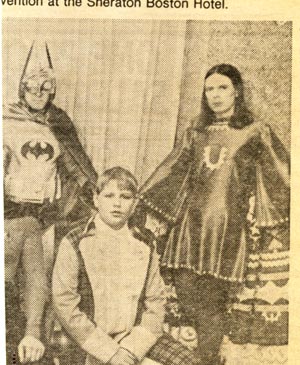
Detail of Boston Herald group photo January 8, 1989. Notice trims on extremities of tunic.
![]()
History Of The Show My Own Experiences Guidelines for the Future